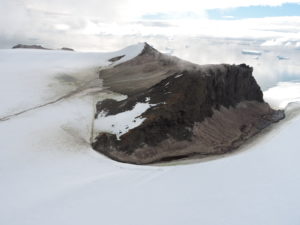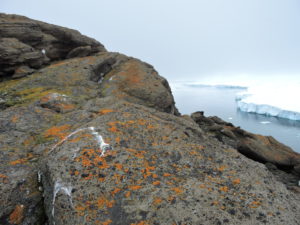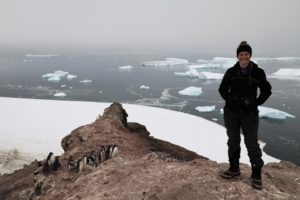For most ecosystems on Earth, human influence is associated with increased fragmentation and loss of habitat, and a corresponding reduction in biodiversity. In Antarctica, the opposite is true when it comes to habitat, but that doesn’t necessarily mean it’s better for biodiversity.
This is the finding of new Australian Antarctic Science Program research published in Nature [Link will open in a new window]on how habitat for terrestrial biodiversity is changing in Antarctica.
The paper’s lead author, PhD candidate Jasmine Lee, set out to answer the question of how human-induced climate change is likely to affect the flora and fauna that currently eke out a living on pockets of land that are permanently ice-free and which make up only 1% of Antarctica. That meant looking into how those ice-free pockets, which are isolated like islands by the ice surrounding them, might change over the next century.
Surprisingly, it was a question that no one had previously thought to ask, Lee says.
“I realised that no one has really done anything about ice-free areas in Antarctica, and ice-free areas are home to over 99% of the terrestrial biodiversity, so they’re very important for the ecosystem,” she says.

Lee, who holds a joint position at the University of Queensland and CSIRO, along with colleagues there and from the Australian Antarctic Division, University of Tasmania and British Antarctic Survey, looked for a way to predict how increasing temperatures might change the distribution of ice around the frozen continent.
It was not an easy task, and involved some complex computer modeling. The first step involved establishing how climate will likely change around Antarctica. The researchers then had to work out a model for how ice would melt with these rising temperatures.
Unfortunately, most existing models of ice-melt in Antarctica are tailored for large ice sheets and glaciers of hundreds of square kilometres in size and containing gigatonnes of ice, to forecast how these melting ice fields will contribute to sea-level rise. But these models weren’t applicable to scenarios of ice several orders of magnitude thinner and not even tens of kilometres in size.
After exhaustive research, Lee found a way to model the melting ice at a more regional scale and – combined with Antarctic-specific climate projections from Thomas Bracegirdle at the British Antarctic Survey – she could finally see how rising temperatures were likely to change the size and distribution of Antarctica’s ice-free areas.
The results were shocking; a 25% increase in ice-free areas across all of Antarctica by the end of this century. A good proportion of this 17,000 kilometres-squared- worth of ice-free terrain would emerge on the Antarctic Peninsula, representing a tripling of existing ice-free land.
The impact of this increase in ice-free land looks, at a passing glance, to be a positive. There will be more land on which mosses, lichens and plants can grow, invertebrates can thrive, and some species of penguins can nest. It will lead to increasing connectivity between habitats, between the ‘islands’ previously kept isolated by ice.
But this apparent good news is far from it, because while this changing environment might be more hospitable for native species, it’s also more hospitable for non-native and invasive species. There are already early warning signs that species like the invasive Poa annua grass are gaining a foothold in areas that until recently were too cold for them to survive.
“At the moment, the biggest protection the continent has is its harsh conditions, so when something gets there that shouldn’t get there, it dies because it can’t survive the conditions,” Lee says.
But that looks set to change, as temperatures start to creep above freezing, and the new arrivals could pose a significant threat to residents.
“Once they establish, we’re not really sure how native species will handle increased competition, because they’ve evolved to be isolated,” Lee says.

In the short term, the changing conditions are likely to see more non-native species establishing themselves among the natives in the little pockets of ice-free land, and both groups expanding as their territory expands. In the long term however, there’s a good chance the native species will lose out to the more adaptable and competitive non-natives.
“The environment could start homogenizing so that less competitive species start to die out and become extinct, and the more competitive ones - which are quite possibly going to include lots of non-native species become invasive - they’ll win.”
The best solution to this impending crisis is also the hardest: stop, and possibly reverse, human-induced climate change. Lee says that as challenging as this might seem to the individual, no action is wasted, and even the research stations in Antarctica could help to do their bit to reduce their greenhouse gas emissions.
Other conservation approaches focus on preventing non-native and invasive species from arriving in the first place, and eliminating them when they do. Ironically, scientists themselves are one of the main vectors for the introduction of non-native species to Antarctica. Lee says a 2012 study by Chown and colleagues[Link will open in a new window] found researchers were unwittingly bringing in non-native seeds in their shoes, clothes and bags. Tourists are also potentially bringing in plant material, and as climate warms, some species – particularly invertebrates – are rafting across ocean currents[Link will open in a new window] from other continents on pieces of kelp and other floating material.

While tighter biosecurity for human visitors could reduce the number of non-native species being brought to Antarctic shores, the studies senior author – Aleks Terauds from the Australian Antarctic Division, said the research could also help identify particularly vulnerable regions for protection.
“This information can feed into Antarctic research and management, so we can incorporate the ice-free expansion models into protected area planning to figure out where our next protected areas should be,” he says.
Lee’s Nature paper is only the first chapter of her PhD thesis. Subsequent chapters will look at how vulnerable different species are to the impact of warming and expansion of ice-free areas, and how their distributions are likely to change.
“Finally, we want to tie it all together with conservation planning and prioritise conservation actions for different biodiversity groups in different regions, based on the threatening processes, whether that be climate change, invasive species, scientific study or tourism,” she says.
Lee’s research is the culmination of a long love-affair with Antarctica and the sub-Antarctic, which began at age 14 when she saw a documentary on Macquarie Island.
“I was like, I want to do that, I want to go there,” she says. “I think I was very lucky to find the opportunity to be able to do this.”
Nature publication:
Climate change drives expansion of Antarctic ice-free habitat[Link will open in a new window] Jasmine R. Lee
